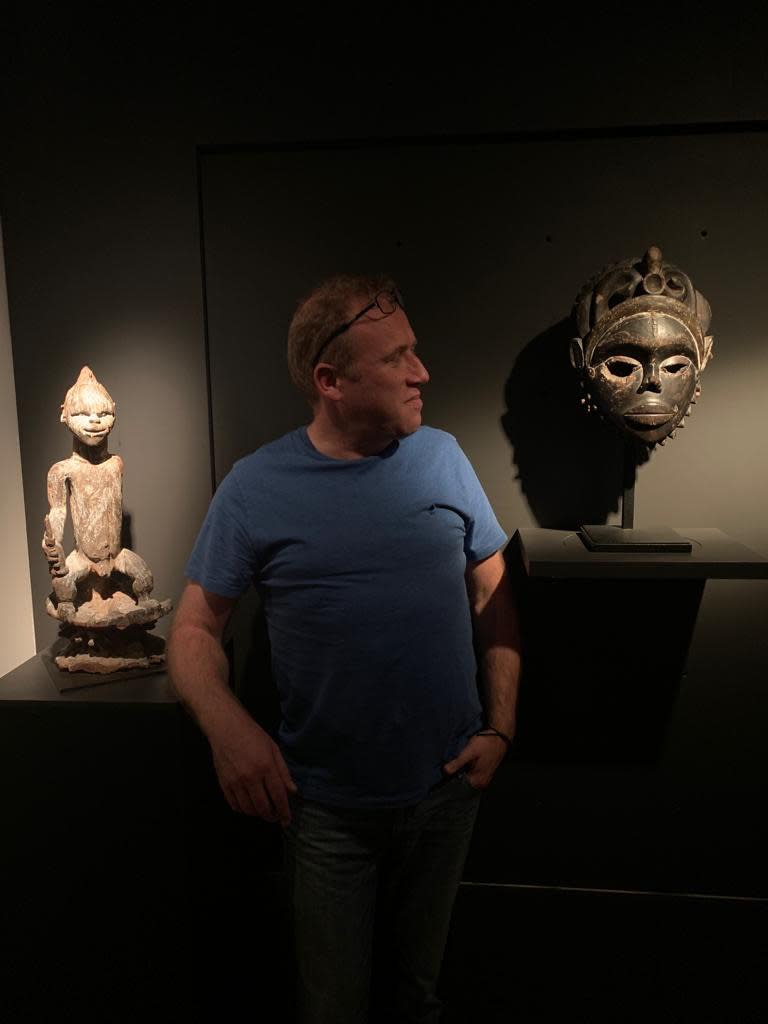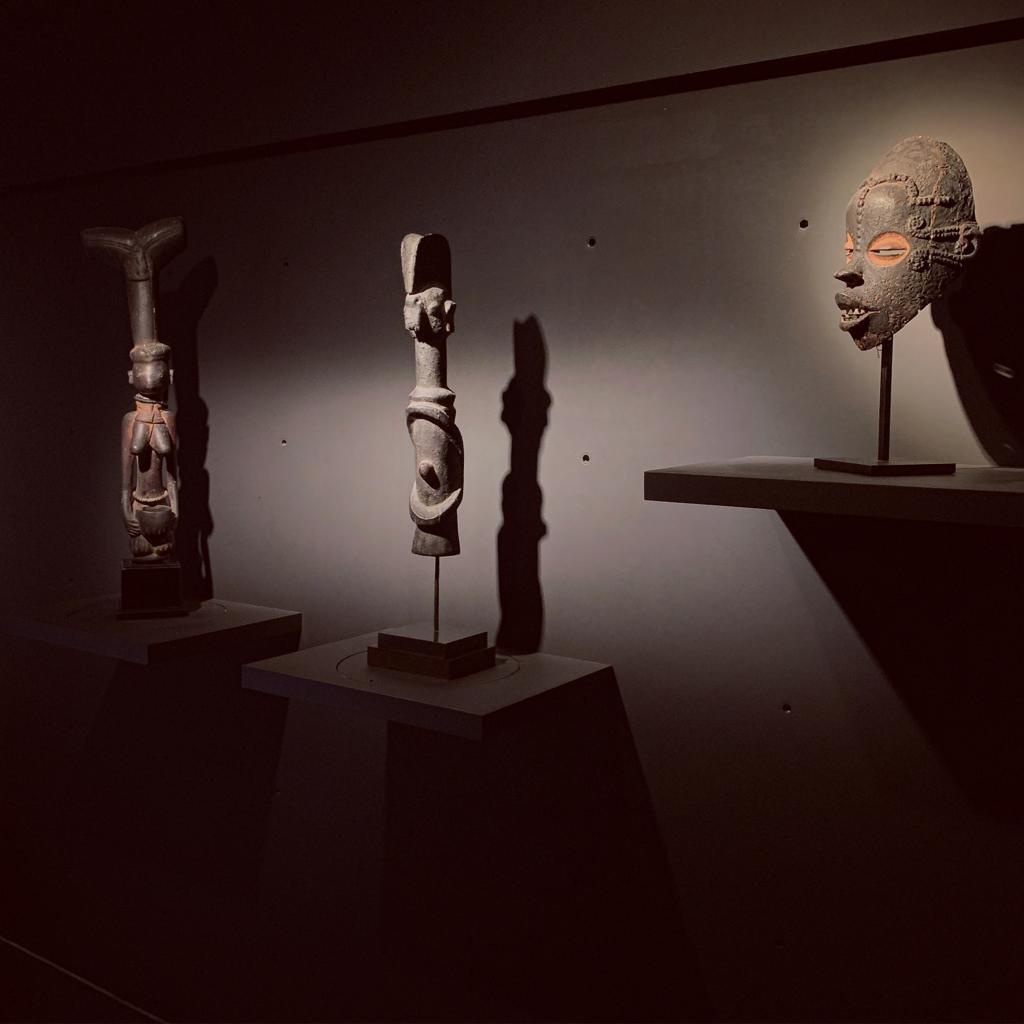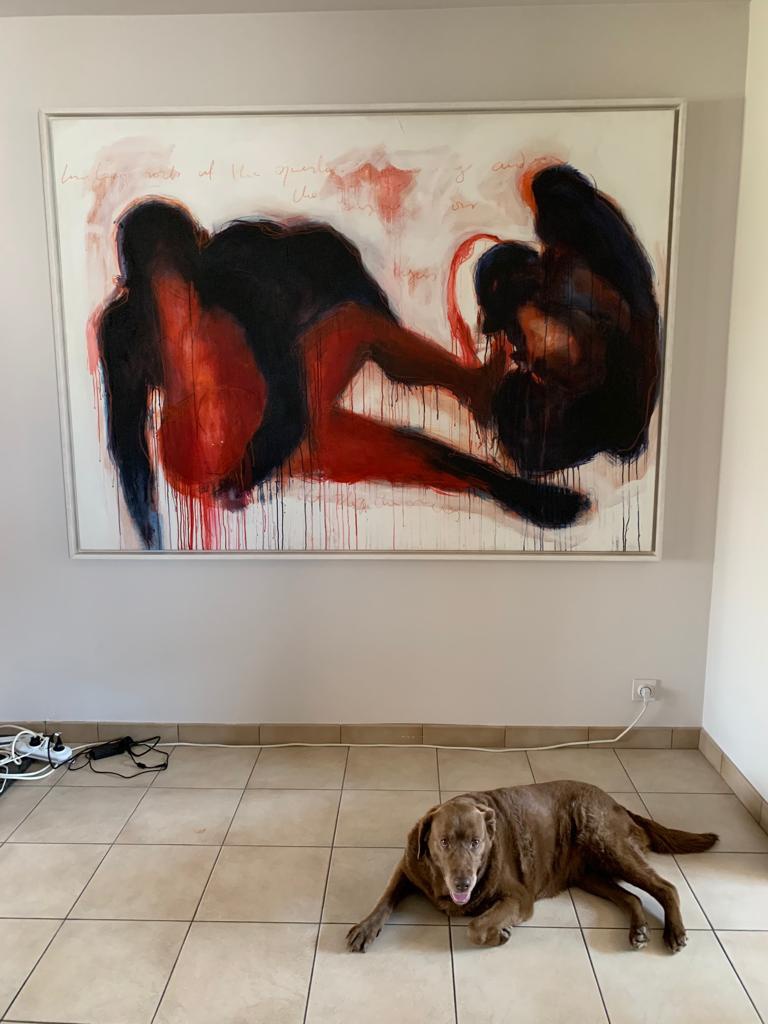
How did you start collecting African Art ?
I don’t think there was a defining moment when I became a collector. My interest in African Art grew gradually from different angles over a long period. I remember as a child being fascinated with everything African: culture, society, politics, and nature. That curiosity, combined with a basic general interest in the Arts, started when I was around 14 years old. Those two fascinations made me visit my first exhibition of classical African Art with my dad at the former Antwerp Ethnographic Art Museum in 1993, “Faces of the Spirit” curated by Frank Herreman and presenting about 40 Congolese masks. My very first acquisition, a Lega mask, followed soon after. When I was 17 years old, I started putting adverts in local newspapers hoping to find African art in old colonial collections. In the years after I got to see quite a lot of African art; with numerous visits to the Tervuren museum and Antwerp Ethnographic Museum. That Lega mask, although a rather well made fake, I still keep as the only object left of that early period for sentimental reasons. During my university years I focused on my studies, yet this passion for African art slumbered in the background. After graduating, I lived in Düsseldorf for a while and discovered the art gallery of Han Simonis. Those visits further awakened the ambition to start collecting on a more serious level. At the age of 23, I didn’t yet have the resources to buy at the galleries and instead bought some minor works through websites such as Ebay. My first more ‘serious’ acquisition was in 2007, a Katsina terracotta head at the sale of the Francine Maurer collection at the Pierre Bergé auction house in Brussels for about € 1000. The will to create a collection and to continue this passion truly started then. Fifteen years later, my collecting passion now forms a nice counterweight to my professional activities as freelance HR consultant. I think one needs a passion in life, and collecting African Art offers exactly this, both aesthetically, culturally, intellectually and socially.
Would you say there’s a theme in your collection ?
The last five years I’ve been trying to bring such a common thread in my collection. If there was one thing lacking before, it was such a defined theme – except for my wish to acquire the best possible objects my budget allowed. I was convinced this criterium was a good and pragmatic way to build a decent collection. However, these last few years I have decided to focus on masks and sculptures from Nigeria – this does ask some discipline seen my general interest in African Art. Yet I felt it became necessary to focus, both to build up a collection, as to gain a deeper knowledge and ‘eye’ for the arts of a specific region. From a financial perspective as well this choice made sense, as Nigerian art still is under appreciated commerically. Through the years, my taste was continuously evolving and becoming more refined, a rather ‘natural’ evolution for every collector, I think. Yet, my wallet was not following my taste. With some exceptions, such as important Mumuye or Mbembe figures, classical Nigerian artworks still could fit into my budget, probably a little bit easier so than say Congolese or Gabonese art. However, I do still acquire other works – last year I bought a Kanak statue from New Caledonia, talking about straying…
Besides the financial aspect, can you define the reasons why you decided to focus specifically on Nigerian Art?
First of all, as a cultural sphere, it is a very diverse region, especially in terms of artistic output, even more so than art market favorites such as Gabon. That’s no surprise, as it is the biggest nation in Africa. Second, the art of some specific regions, especially the cultures along the Benue River, from the Igala all the way up to the Montol, matches my personal aesthetic preferences closely, which I would describe as the love for pure forms with a rough edge. But in that same Nigeria, one also finds refined court art with the Yoruba peoples. Nigeria is my focus now, but that might change over the years. For me, this evolution as a collector is important, yet unpredictable. Collecting is about objects, but I also experience it as an intellectual endeavor. Oddly enough my first acquisition of a Nigerian object, an Ibibio sickness mask I got after hours of, rather wine-drenched, negotiating with Lucien Van de Velde in 2011, both predates but probably also pre-formed my decision to focus on Nigerian art. It was my most major purchase at that time and an important moment in my life as a collector.
Talking about this Ibibio mask; it’s quite a known mask, once having belonged to the collection of René Rasmussen. How important is an object’s provenance for you?
That’s a good question. The importance of the provenance is always a point of discussion as a collector. It’s somewhat twofold. On the one hand, I’m not the type of the collector that acquires an object for its provenance. When evaluating a possible purchase, I try as much as possible to put provenance aside. As such it’s not important in the judgement of an object. However, I’m realistic enough to realize its impact on the value of an object when making a conscious choice to put a substantial amount of your savings in an acquisition. So, I do have it in mind and realize that in this current market a high importance is placed on provenance. For me the most valuable kind of provenance is one that beyond doubt indicates the date of entry on the market of a certain object. In such a case it presents a real added value to an work of art, confirming its supposed age, especially if it already arrived in Europe in the early decades of the twentieth century. So, in a nutshell I try to keep a rather pragmatic middle ground between elitist ‘provenance buying’ & arrogant ‘I don’t need provenance’…

A Yoruba shango staff, Wurkun statue, and Idoma mask in the collection of Jan de Clerck.
Can you tell us something about your aesthetic preferences?
I must admit I still find it challenging to define those. In discussions with visiting collectors my taste often gets more clearly outlined. I think mainly I’m drawn to purity of forms. I look for sculptors who did more with less. Visually overloaded or baroque sculpture is habitually more difficult for me to appreciate. Clear signs of ritual life are important. Visible age and patina are features I really need to find in a work of art. This is so important because it’s the cultural importance, the relevant purpose those artworks served that drew me to African art in the first place. While I’m not too fond of overly realistic artworks, I wouldn’t necessarily say I prefer the abstract. I’m somewhere in between the figurative and the non-figurative, looking for original ideas to present the human anatomy. Collecting African Art feels like a journey, like a river that flows; one’s taste is not static. I find myself looking for artworks that exude a certain power and force, a strength expressed through sculpture. Yet, it is a controlled, withheld, maybe even introvert power I look for. Extravert or sometimes even aggressive expressions of this force usually appeal less to me. A good example are the headdresses from the Ekoi complex. I’d say over 90% of the ones I encounter are too wild, too violent, too expressionistic also for my taste – yet the one you exhibited for example during “Unsettled” had a clear, ‘silent’ power to it yet holding absolute elegance and a softness that transcended the genre.
How many objects you buy each year and what are your last purchases?
The last 10 years, I haven’t bought more than 5 objects a year, sometimes just two. There’s a lot of art available on the market, but I try to remain somewhat disciplined and focused, sometimes easier said than done of course. My last purchase was a seated figure, supposedly from the Igala (or Kwale Igbo) people that I acquired from Adrian Schlag in Paris during Parcours des Mondes. It corresponds 100% with my current taste: Nigerian, clearly ancient and extensively used, and with an engaging presence. I didn’t buy it on the spot, yet the purchase was finalized within 12 hours, which for me is already very fast. Normally, objects need to sink in. I’ll discuss them with friends and try to avoid relying on my own eye only. I always try to get the opinion of a few people whose experience I respect. I like looking to an object through someone else’s eyes - even if their feedback is negative. This dialectic process for me is crucial, to test if an object survives such an intersubjective vetting process. It doesn’t necessarily mean I solely rely on the opinion of fellow collectors, but it is an integral part in my acquisition process as a collector. Buying on a hunch or love at first sight is a tad too…emotional for how I’m wired, I guess.
Tells us something about the object you acquired from Duende Art Projects?
The selection of classical African Art in the exhibition “Unsettled” corresponded strongly with my personal taste and I was delighted to acquire the Wurkun statue, which now has a central place in my living room. When I first I saw the exhibition, I mainly focused on the spectacular Ibibio sickness mask, which could have been a good match with the Ibibio mask in my collection. The janus Ejagham helmet mask once exhibited in Utotombo also was my absolute favorite, but above my budget. Only with a second visit, I truly came to understand the qualities of the Wurkun statue and realized that it ticked all the boxes I’m looking for in an object and. As I already had a Wurkun figure in my collection, I had passed the statue during my first visit. Yet, upon closer study it drew my attention. Back home I started with my research, comparing it to all known figures of the type in the image database of Guy van Rijn (a process I repeated hundreds of times probably in the last 15 years). In my personal opinion, it belongs in the top 5 of its corpus. It was fascinating to identify the details in which it is superior to the Wurkun I already owned. As with the Ibibio mask I acquired from Lucien Van de Velde it wasn’t love at first sight; I needed to warm up and grow into the object – yet, as the Ibibio mask, the figure has become one of the cornerstones in my collection. As said before, love at first sight is not necessarily the strongest…

Beatrice Wanjiku, A Fragment of Ourselves Returning V, 2018 - Mixed media on canvas - 146 x 203 cm
Can you share other recent duende moments?
The first time I saw the seated Igala statue during Parcours des Mondes in September was a true duende moment. Immediate goosebumps. Friends had told me they had seen something ‘for me’, so I was warned, yet standing in front of it for the first time was a magical moment. I have such feelings quite frequently and it is one of the reasons I was drawn to African Art and why it continues to be such an important part of my life. I love the visceral impact these ancient objects can have. The best classical African Art has that power to stop and engage anyone who stands in front of it. It is somehow a trace of what that object meant in its original cultural setting. While disconnected from its original ritual context, I have the feeling (or illusion?) I can still feel this original effect. The best art successfully conveys certain emotions across time and place.
You have a major work by the Kenyan painter Beatrice Wanjiku centrally in your living room; do you also collect contemporary African Art?
I wouldn’t call myself a collector of contemporary African Art as I still lack the experience and knowledge. I discovered the work of Beatrice thanks to Duende Art Projects and stimulated by collector-friends Adenike Cosgrove and Deborah Glasser, and was immediately struck by it. I don’t think it is a coincidence her paintings attract me so much. We were discussing emotional impact before, and this deep silent strength I also recognized in Beatrice’s paintings. The universality of certain emotions resonates deeply with me. Exploring the human condition, I love how her work can be understood by anyone, bringing out comparable experiences when observed by viewers with totally different cultural backgrounds. Wanjiku touches something deeply human in her paintings, and for me it is impossible to remain indifferent to her work. For me, collecting art from the African continent is all about being profoundly touched. So yeah, quite possibly this rather new interest also in the contemporary African arts might grow further in the future. By the way, that’s one of the things I really appreciate & admire in what you’re doing with Duende Art Projects: bridging both classical & contemporary African arts!